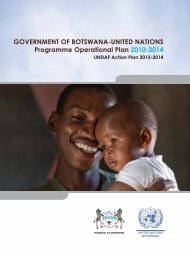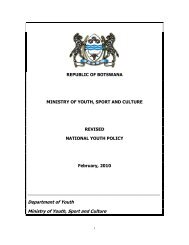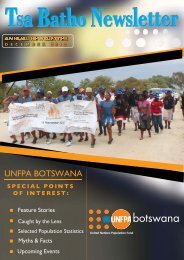Ageing in the Twenty-First Century: - HelpAge International
Ageing in the Twenty-First Century: - HelpAge International
Ageing in the Twenty-First Century: - HelpAge International
You also want an ePaper? Increase the reach of your titles
YUMPU automatically turns print PDFs into web optimized ePapers that Google loves.
Chapter 2:<br />
A fresh look at evidence<br />
This chapter starts by describ<strong>in</strong>g <strong>the</strong> vital role that older people play <strong>in</strong><br />
society. It <strong>the</strong>n analyses <strong>the</strong> situation of older persons <strong>in</strong> three areas and<br />
highlights <strong>the</strong> challenges: <strong>in</strong>come security, health and enabl<strong>in</strong>g environments.<br />
It provides examples of how <strong>the</strong>se challenges are addressed <strong>in</strong> develop<strong>in</strong>g<br />
and developed countries, and <strong>in</strong>cludes responses from older persons who<br />
participated <strong>in</strong> <strong>the</strong> consultations for this report.<br />
A vital role <strong>in</strong> society<br />
Peter Caton/<strong>HelpAge</strong> <strong>International</strong><br />
“A society for all ages encompasses <strong>the</strong> goal of provid<strong>in</strong>g<br />
older persons with <strong>the</strong> opportunity to cont<strong>in</strong>ue contribut<strong>in</strong>g<br />
to society.” (Madrid Plan, para. 19)<br />
The Madrid Plan po<strong>in</strong>ts out that older persons across <strong>the</strong><br />
world make a vast contribution to society. It explicitly<br />
calls for <strong>the</strong> recognition of <strong>the</strong>ir contribution and for<br />
<strong>the</strong> <strong>in</strong>clusion of older persons <strong>in</strong> decision-mak<strong>in</strong>g<br />
processes at all levels. 1 Older persons contribute both<br />
f<strong>in</strong>ancially and <strong>in</strong> many ways that are not measured<br />
<strong>in</strong> economic terms – as mediators, educators, workers,<br />
volunteers, homemakers and caregivers, as sources of<br />
knowledge and historical memory, and as guardians<br />
of culture. Increas<strong>in</strong>gly, older generations are becom<strong>in</strong>g<br />
active <strong>in</strong> political processes, form<strong>in</strong>g <strong>the</strong>ir own<br />
organizations and campaign<strong>in</strong>g for change. Older<br />
persons <strong>in</strong> rural areas often have expert knowledge<br />
of farm<strong>in</strong>g practices, <strong>in</strong>clud<strong>in</strong>g ways of cop<strong>in</strong>g with<br />
environmental shocks and food shortages, which may<br />
be crucial for <strong>the</strong> survival of rural communities <strong>in</strong><br />
times of crisis.<br />
Although some progress has been achieved <strong>in</strong> enabl<strong>in</strong>g<br />
older persons to actively participate <strong>in</strong> society and<br />
<strong>in</strong> recogniz<strong>in</strong>g <strong>the</strong>ir contributions, <strong>the</strong>re are still<br />
important challenges. In spite of <strong>the</strong> grow<strong>in</strong>g<br />
recognition of <strong>the</strong> role of older persons <strong>in</strong> society,<br />
<strong>the</strong>re is still a long way to go. In many areas, older<br />
men and women are still seen as dependants, and as a<br />
burden to society. Social participation is still low and<br />
mechanisms to enhance it are still not well developed.<br />
In addition, it must be recognized that social<br />
participation is not possible for all older persons.<br />
Increas<strong>in</strong>g disability may m<strong>in</strong>imize <strong>the</strong> possibilities of<br />
be<strong>in</strong>g socially active. The challenge lies <strong>in</strong> how to<br />
ensure at least some level of <strong>in</strong>teraction that avoids<br />
isolation and promotes more communication with peers<br />
and families, even <strong>in</strong> <strong>the</strong> presence of disabilities.<br />
Social and cultural contributions:<br />
Caregiv<strong>in</strong>g and volunteer<strong>in</strong>g<br />
It is <strong>in</strong> <strong>the</strong> area of childcare that older people, especially<br />
older women, make a particularly vital contribution.<br />
Families all over <strong>the</strong> world rely on grandparents to care<br />
for children so that parents can work, or to take on sole<br />
care of children whose parents have died. Older men<br />
and women <strong>in</strong>volved <strong>in</strong> consultations for this report felt<br />
that caregiv<strong>in</strong>g was one of <strong>the</strong>ir ma<strong>in</strong> contributions.<br />
For example, a study of Bolivian migrants who moved to<br />
Spa<strong>in</strong> found that 69 per cent left <strong>the</strong>ir children at home,<br />
usually with grandparents. 2 In rural Ch<strong>in</strong>a, grandparents<br />
care for 38 per cent of children aged under five whose<br />
parents have gone to work <strong>in</strong> cities. 3 In one town <strong>in</strong><br />
Colombia, around a third of <strong>in</strong>ternally displaced older<br />
persons are responsible for car<strong>in</strong>g for grandchildren. 4<br />
35







